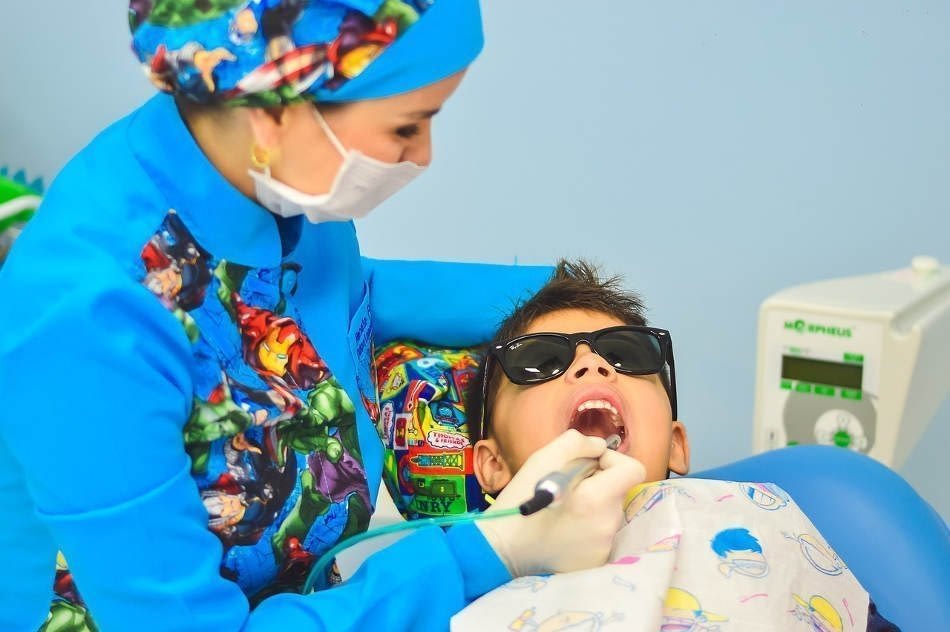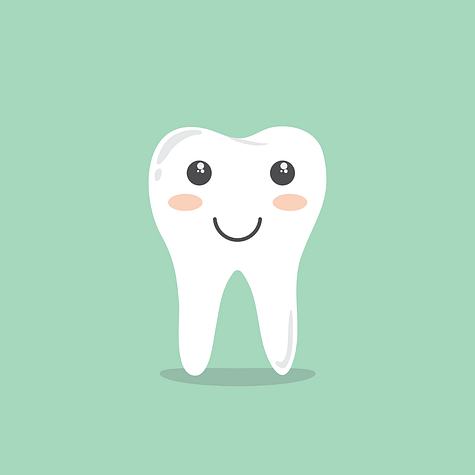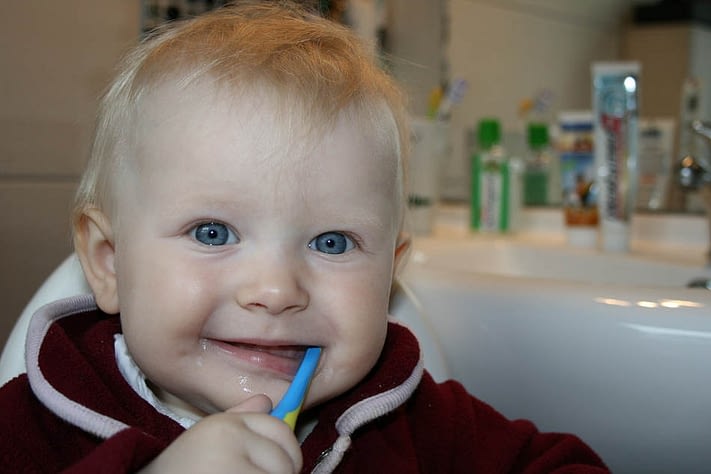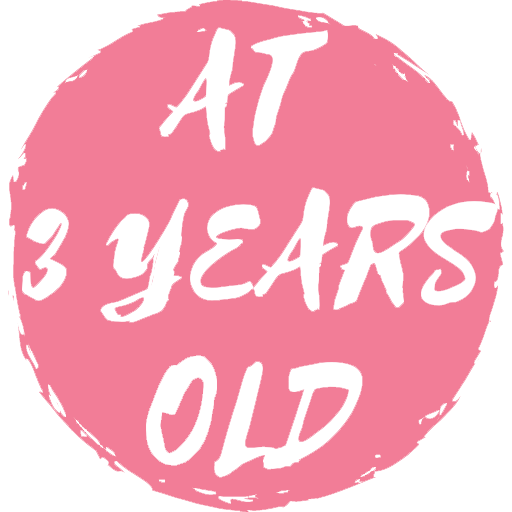Do 3 Year Olds Cut Teeth?

I once knew a couple whose baby was born with teeth!It’s hard to imagine your little one when they were inside their mummy with little chompers, but it’s true. The time when children’s teeth can cut (or the more scientific name for it is erupt) varies from child to child. The question is, do 3 year olds cut teeth?
Yes, 3 year olds cut teeth. Most children have their first set of teeth by the time they are 3 years old. This first set isn’t the same set of teeth that your 3 year old will carry into adulthood though. These first set are called the primary teeth (other more common names for them are milk teeth or baby teeth). There are around 20 of them in total in your child’s mouth by the time they have all popped through. This primary set of teeth will last them until they are around 5 or 6 years old, they will then start to fall out one by one.
Teeth should first start popping up at around 6 to 12 months in most babies. They have been there all along preparing, even when your baby was in the womb. When your 3 year old grows up and is around 5 or 6, your child’s permanent teeth start to come through. These permanent teeth then push out the primary ones above them. This is why 5 and 6 year olds start to get that cute gap tooth smile.
It takes your child until they are 12 or 13 to fully complete that process and finally get their full set of permanent teeth (minus their wisdom teeth, they come later).
HOW TO TELL IF YOUR TODDLER’S TEETH ARE CUTTING NORMALLY
The way in which children’s teeth cut (erupt) is quite unusual. They always cut in the same set pattern. When your child has their first teeth erupt through, it will be their front two bottom teeth. After this, the next teeth to come through are the top four front teeth. Then after your child has their front teeth, the rest usually come in pairs on the outside of the teeth that are already there. Then at 3 years of age they should have their full primary set in place.

HOW FAST SHOULD MY 3 YEAR OLD’S TEETH CUT?
Generally, you are looking for around 4 teeth for every 6 months of their life from the age of 6-12 months. That’s sounds quite fast, but it’s completely normal.
Interestingly girls normally get their teeth before boys do and lower teeth generally cut before upper ones. Keep in mind that your child’s primary teeth aren’t the same as our adult ones there are differences, so don’t worry if you notice that they are:
- Smaller in size than permanent teeth.
- Whiter in color than permanent teeth.
When a child reaches the age of 4, their facial bones and jaw start to grow. This means that spaces start to appear between their primary teeth. This is perfectly normal development, their body is creating that space for their permanent set of teeth to come through.
WHY CARING FOR THEIR BABY TEETH IS VITAL
Baby teeth don’t hang around long, just a few short years. That doesn’t mean that it’s not important to care for them properly. Baby teeth actually play quite a few important roles in your 3 year old’s development.
- Save space for permanent teeth: Baby teeth actually have the important job of reserving the space that the permanent teeth will eventually take up. The permanent teeth need their path cleared so they can eventually come and take over the job.
- Help to shape their face: When adults have no teeth you can immediately see it in their face shape, the slightly sunken cheeks are a giveaway. Baby teeth help give your child their natural, beautiful face shape.
- Help your child’s speech development: Teeth aren’t only for chewing (although that is a pretty important job they do!), they also help us all to form words. The shape of our mouths and teeth are vitally important for us to help develop our speech and use our language every day. The child needs the first set so they can start learning to talk as early as possible.
- Decay in baby teeth: If our 3 year old’s teeth have decay, this might make it harder for them to eat certain foods and get the nutrition that they need to grow up fit and healthy.
- Decay can cause permanent damage: Decay in baby teeth can cause damage in the permanent set below. You don’t want to let your 3 year old damage the set of teeth that they will be using for the rest of their lives.

HOW TO CARE FOR YOUR 3 YEAR OLD’S TEETH
As I have proven in the section above, just because baby teeth are only here for a few years, they still need to be cared for. It’s quick and easy to make sure that your 3 year old keeps their beautiful smile, even if they only have a few teeth to fill it with!
Even before teeth arrive in your babies mouth it’s a good idea to start cleaning their gums. You can do this with a soft baby toothbrush or just a wet cloth. This will make sure that any bacteria won’t start to build up in their mouth.
You should start brushing your child’s teeth with a soft toothbrush and kids fluoride toothpaste as soon as you see their teeth coming through. Around 3 years old is the time you will want to start using a pea sized amount of fluoride toothpaste, with a soft bristled brush. You should brush their teeth twice a day, morning and evening.
HOW TO BRUSH YOUR 3 YEAR OLD’S TEETH IN 6 STEPS
- Stand or sit behind your 3 year old so they feel safe and secure. Ideally, do it in front of a mirror so they can watch and learn what is going on.
- Gently hold their chin so their head presses lightly against your body.
- Put a pea sized amount of fluoride toothpaste on a soft bristled brush and gently wet the brush head with water.
- Brush the surfaces of their teeth with a gentle circular motion and light pressure. Then angle the brush in towards their gums. Lastly, finish off by brushing the chewing surfaces of their teeth.
- Gently brush your child’s tongue to get rid of any bacteria hiding on there.
- Make sure they learn to spit the toothpaste out rather than swallowing. After they have spit most of it out, it isn’t essential for them to rinse their mouth as the fluoride in the toothpaste left behind can help protect their teeth further.
WHY DRINKING WATER IS GOOD FOR THEIR TEETH
Make sure your three year old is staying away from sugary drinks in between meals. This can cause excessive amounts of bacteria to feed on the sugars in their mouth and produce a weak acid that causes tooth decay.
WHEN IS IT TIME FOR THEIR FIRST VISIT TO THE DENTIST?
The advice on when your child should first visit the dentist is at around 6 months after their first tooth has shown or when they are around 1 years old. If you have any concerns before then, just make an appointment and speak to a professional.
THIS IS THE WAY TO BREEZE THROUGH TEETHING
Teething will obviously cause your baby discomfort, which will make them fussy. There are ways we can help them get through this difficult time. The problem is everyone seems to have advice on how to help them, some of it much better than others. I was personally tired of having well meaning older people tell me to dip their pacifier in spirits! No thanks! That’s why I wanted to discuss the best ways I have found to help your little one through teething.
- Teething toys: They are a great first go to for your child just make sure they are extra clean. Some teething toys you can even pop into the refrigerator. Those chilled toys must feel like heaven for them against their hot sore gums. If you haven’t got a teething toy then you can use a clean wet face cloth.
- Teething gels / ointments: Some of these gels and ointments can work wonders for especially fussy babies. They come in a variety of strengths. You can try other the counter options first, always remember to get the advice of a professional on any drug that you may want to try and make sure they are suitable first.
- Comfort: A big hug from you, being held or just being caressed can work wonders for them when they are going through pain. Your child feels safest when they are with you. The amount that soothing like this can go towards easing their troubled gums can sometimes be astonishing.
Please don’t be tempted to use teething cookies or biscuits, as you might expect, these contain sugar in. The sugars then make the perfect environment in your child’s mouth for the decay of their brand new teeth.

Leave a Reply